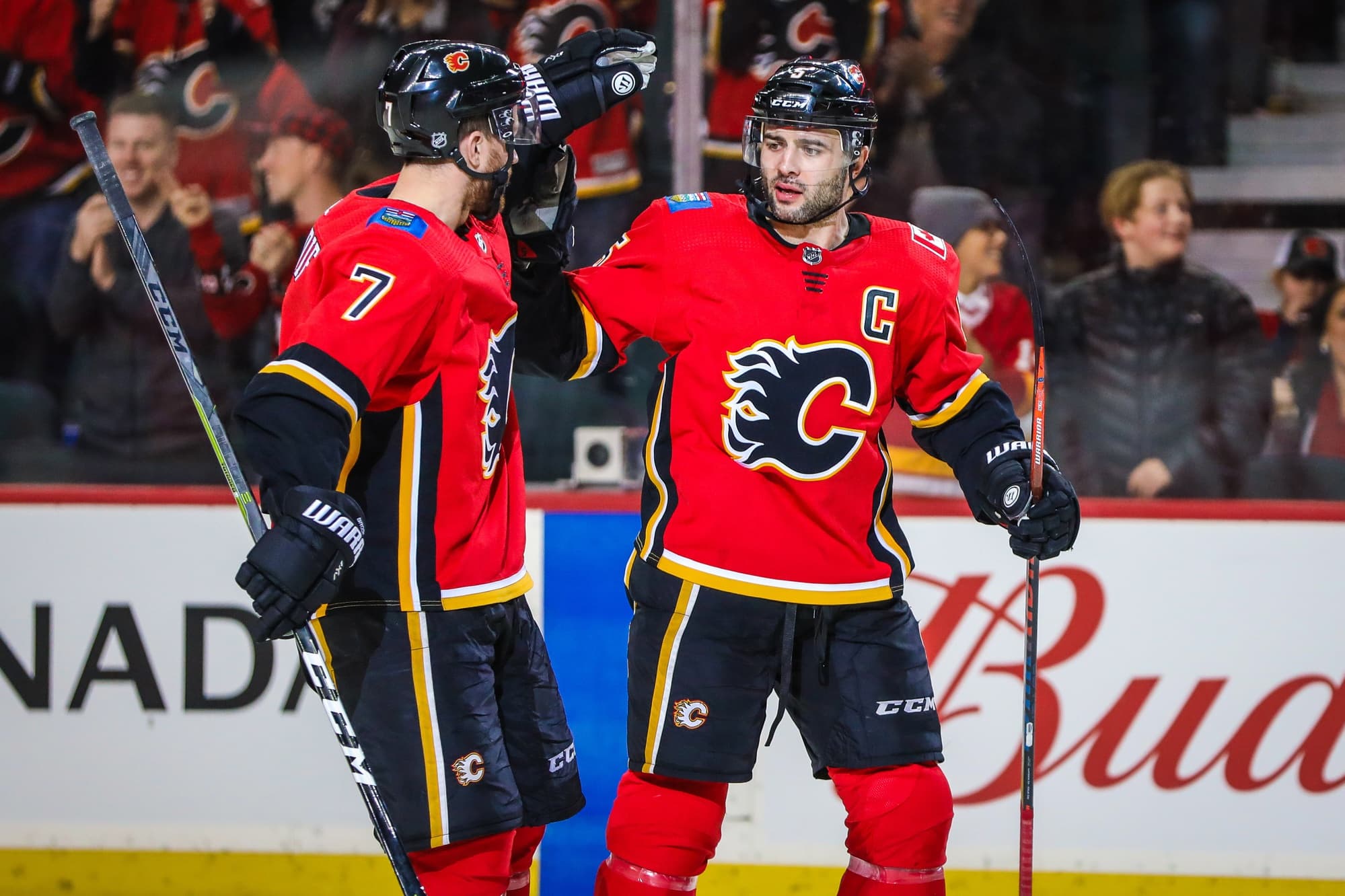Which Flames defensive pairing scheme worked the best?

By Ryan Pike
3 years agoAfter an excellent 2018-19 regular season, the Calgary Flames have had a weird, frustrating 2019-20 season. They’ve had to be resilient in a lot of different ways, one of which was rolling with the punches as far as illness and injury on their blueline goes.
The Flames had a bunch of different set-ups for their defensive pairs this season. With Travis Hamonic unavailable for the post-season, which of their many defensive schemes was the best?
11 guys in different combinations
The Flames operated with 11 different players on their blueline this season, nine of which are available to them in the playoffs:
- Mark Giordano
- TJ Brodie
- Noah Hanifin
- Rasmus Andersson
- Michael Stone
- Oliver Kylington
- Alexander Yelesin
- Derek Forbort
- Erik Gustafsson
- Travis Hamonic (unavailable)
- Brandon Davidson (traded to San Jose)
Brodie, Giordano and Hamonic all missed big chunks of the season due to various reasons. So here’s how the coaching staff shuffled things up.
Scheme 1: the core five, plus Kylington
Giordano-Brodie, Hanifin-Hamonic, Kylington-Andersson
This group was the default for most of the season, a tendency that both Bill Peters and Geoff Ward had in common. In 31 games (25 against playoff teams), this group registered 16 wins. They registered a 50.4% Corsi For, 51.4% Scoring Chances For and 48.5% High-Danger Chances For. They were reliable and good at possession, but seemed to bleed good chances.
Scheme 2: the core five, plus Stone
Giordano-Andersson, Hanifin-Hamonic, Brodie-Stone
Sometimes the coaching staff wanted some beef, so Kylington was swapped out for Stone. In 11 games (eight against playoff teams), they had seven wins. They registered a 49.5% Corsi For, 47.6% Scoring Chances For and 52.7% High-Danger Chances For. They were decent at possession hockey and guarding against strong chances, but were generally out-chanced.
Scheme 3: no Brodie, so Kylington and Stone both play
Giordano-Andersson, Hanifin-Hamonic, Kylington-Stone
With Brodie out for a trio of games, Stone and Kylngton both played. In 3 games against playoff teams, they had zero wins. They had good possession stats – 54.2% Corsi For, 49.0% Scoring Chances For and 51.9% High-Danger Chances For – but two of the three losses were one-sided so they don’t really matter much.
Scheme 4: no Brodie, no Hamonic
Giordano-Andersson, Hanifin-Stone, Kylington-Davidson
Now it gets lean. With Brodie and Hamonic out, Stone slotted into the top four (and Davidson played). In three games against playoff teams, they won once. They had a 51.6% Corsi For, but bled scoring chances with 47.1% Scoring Chances For and 37.5% High-Danger Chances For.
Scheme 5: no Hamonic, so Kylington and Stone both play
Giordano-Brodie, Hanifin-Andersson, Kylington-Stone
With Hamonic out for a trio of games, Stone and Kylington both played. They played three games (one against playoff teams) and won twice. They were generally okay: 49.8% Corsi For, 47.4% Scoring Chances For and 52.7% High-Danger Chances For.
Scheme 6: the core five, plus Stone, but Brodie stays on the top pair
Giordano-Brodie, Hanifin-Hamonic, Stone-Andersson
This is an alternate version of Scheme 2, except the Flames utilized a weird third pairing with the two right shooting guys. They played a pair of games, both against playoff teams, and won once. They were okay: 47.5% Corsi For, 47.4% Scoring Chances For and 58.6% High-Danger Chances For. They didn’t have the puck much, but they defended decently.
Scheme 7: no Giordano, no Hamonic, Davidson plays
Hanifin-Andersson, Brodie-Stone, Kylington-Davidson
For three games with no Giordano or Hamonic, Davidson played and Yelesin sat. The Flames played one playoff team and won twice. They were decent: 47.9% Corsi For, 51.7% Scoring Chances For and 56.5% High-Danger Chances For.
Scheme 8: no Giordano, no Hamonic, Yelesin plays
Hanifin-Andersson, Brodie-Stone, Kylington-Yelesin
For four games with no Giordano or Hamonic, Yelesin played and Davidson sat. The Flames played one playoff team and won twice. They were low-key strong: 54.7% Corsi For, 56.6% Scoring Chances For and 56.8% High-Danger Chances For. Aside from the team not burying their offensive chances, they were sharp.
Scheme 9: post deadline, no Hamonic
Giordano-Brodie, Hanifin-Andersson, Forbort-Gustafsson
This is the core group after the trade deadline. In six games, all against playoff teams, they won three. They were okay: 48.5% Corsi For, 47.6% Scoring Chances For and 51.0% High-Danger Chances For.
The one-offs
- Game 54 (L): Giordano-Andersson, Brodie-Hamonic, Hanifin-Stone
- Game 55 (L): Hanifin-Andersson, Brodie-Hamonic, Davidson-Stone
- Game 56 (W): Hanifin-Andersson, Brodie-Hamonic, Kylington-Stone
- Game 64 (W): Hanifin-Andersson, Brodie-Stone, Forbort-Gustafsson
Handicapping
Based on not having Hamonic or Davidson available, immediately throw out Schemes 1, 2, 3, 4, 6 and 7. That leaves 5, 8 and 9. (For what it’s worth, the classic Scheme 1 seemed to be consistently their best bet if everybody was available.)
On paper, the group that had the best process results (e.g., best possession stats) was Scheme 8 with Yelesin playing. But in a playoff series, it seems iffy to use a guy playing his first year in North America (and who has all of four NHL games to his resume). And there’s no damn way Giordano won’t be playing anyway, so Scheme 8 goes into the dumpster, too.
Both of the remaining schemes had uninspiring results. If the choice is between using Kylington and Stone or Gustafsson and Forbort as the third pairing, both choices have their downsides. Because the Flames went out and acquired the latter pair, they seem the most likely choice. But they’re not a definitive upgrade on the other options used by the Flames this season.
Recent articles from Ryan Pike





